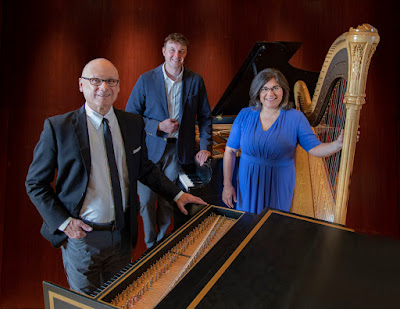Indianapolis Chamber Orchestra offers sesquicentennial tribute to Vaughan Williams
With one of England's greatest composers being widely celebrated this year on his 150th birth anniversary, the
 |
| Soloists Gerber, Zuber, and Muston for Martin's Petite Symphonie Concertante |
Indianapolis Chamber Orchestra on Saturday night presented a program with different aspects of the composer represented in both halves.
Ralph Vaughan Williams' distinctiveness as a rare English master first became apparent in 1910 with Fantasia on a Theme by Thomas Tallis, and his interest in the past of English music also encompassed vernacular styles, which "The Running Set" represented right after intermission.
The latter piece, a straightforward evocation of folk-dance tunes, was a pleasurable rouser in the bright, balanced acoustics of the Schrott Center for the Arts at Butler University. It brought the excellent ICO winds into play for the first time in the concert. Their role was mainly filling out the tone colors of music not designed for individuation. That prismatic focus was to come in the concert finale, Joseph Haydn's Symphony No. 99 in E-flat major.
Part of virtually the greatest impresario triumph in music history, this symphony was one of a dozen commissioned by J.P. Salomon to be introduced by the Austrian composer in his London sojourn of 1794 and 1795. Music director Matthew Kraemer led a sparkling account of No. 99. Only the violins' entrance in the Vivace assai after the first movement's poised introduction was a shade untidy.
The work's most notable feature is the timbral variety the wind instruments lend to the score. Haydn, entering old age according to the norm of his time, was feeling his oats with Salomon's multifaceted assignment. In this work, the innovation in orchestral layout is the latecomer clarinet, added to the wind ensemble of flute, oboe, bassoon, horn, and trumpet. Timpani give a sense of occasion to the piece.
But the work stands out even among the excellent set of London symphonies for its wit and its well-integrated collection of surprises. The finale is continually amazing, using all of Haydn's mature skills in counterpoint, suspense, healthy buoyancy and integration of all materials. The third-movement Menuetto is a gem of his sensitivity to tone color.
Especially in the last movement, wind instruments poke through delightfully, just as children may contribute germanely and precociously to lively adult conversations around this week's Thanksgiving tables (with luck!).
At its climax, Haydn's finale can bear comparison with its much-admired counterpart in Mozart's "Jupiter" Symphony. The strands subject to Haydn's weaving skills are shorter than his younger contemporary's, and thus the complexity is less advanced. But the compositional sophistication in the adolescence of the symphonic form is certainly on the same exalted level.
In the first half, the marquee event was a rare performance of "Petite Symphonie Concertante" by the 20th-century Swiss composer Frank Martin. It's probably not often a conductor can put onstage musicians who are adept concerto partners on the harp, the harpsichord, and the piano. Kraemer selected ICO member Wendy Muston, frequent ICO collaborator Thomas Gerber, and American Pianists Association laureate Eric Zuber, respectively. They were an exemplary team and conscientious interpreters of their unique roles.
In three movements, with a particularly detailed and sensitive Adagio treating the soloists in isolation, Martin displays his idiosyncratic approach to atonal composition. It's ingratiating, never thorny, yet naturally piquant. In this performance, the solo instruments were placed wisely to keep balances clear; I felt fortunate to be sitting closest to Gerber among the three, so that the harpsichord's less penetrating quality was not shadowed by his fellow soloists or the orchestra. I'm guessing there was next to nothing off-balance from other perspectives in this responsive hall.
While probably there are few hungering for other triple concertos with such a set-up, it's easy to be grateful for this one, thanks to Saturday's performance.
The main Vaughan Williams salute was the imperishable Tallis Fantasia. The sacred origin of its theme pervaded the composer's detailed treatment of it for string ensemble. The contrast of textures stood out in the Schrott's duly celebrated environment. The string quartet to which the composer gives judicious emphasis highlighted the richness of the ensemble sonority. The pacing that Kremer set blended warmth and dignity — qualities that showed Vaughan Williams at his best in the piece's blossoming climax.



Comments
Post a Comment